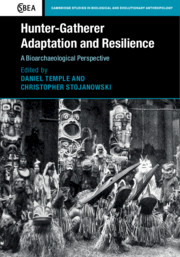Book contents
- Hunter-Gatherer Adaptation and Resilience
- Cambridge Studies in Biological and Evolutionary Anthropology
- Hunter-Gatherer Adaptation and Resilience
- Copyright page
- Contents
- Contributors
- 1 Interrogating the Alterity of Hunter-Gatherers in Bioarchaeological Context: Adaptability, Transformability, and Resilience of Hunter-Gatherers in the Past
- 2 Regional Continuity and Local Challenges to Resilience among Holocene Hunter-Gatherers of the Greater Cape Floristic Region, South Africa
- 3 Hunter-Gatherer Persistence and Demography in Patagonia (Southern South America): The Impact of Ecological Changes during the Pleistocene and Holocene
- 4 The Success and Failure of Resilience in the European Mesolithic
- 5 Persistence of Time: Resilience and Adaptability in Prehistoric Jomon Hunter-Gatherers from the Inland Sea Region of Southwestern Honshu, Japan
- 6 Biomechanics, Habitual Activity, and Resilience among Southern African Hunter-Gatherers and Herders
- 7 Biocultural Adaptation and Resilience in the Hunter-Gatherers of Lagoa Santa, Central-Eastern Brazil
- 8 Resilience among Hunter-Gatherers in Southern California before and after European Colonization: A Bioarchaeological Perspective
- 9 Persistence or Pastoralism: The Challenges of Studying Hunter-Gatherer Resilience in Africa
- 10 Ancient Mortuary Ritual and Cultural Resilience on the Northwest Coast of North America
- 11 Bioarchaeological Evidence for Cultural Resilience at Point Hope, Alaska: Persistence and Memory in the Ontology of Personhood in Northern Hunter-Gatherers
- 12 Biocultural Perspectives on Interpersonal Violence in the Prehistoric San Francisco Bay Area
- 13 The Discovery and Rapid Demise of the Sadlermiut
- 14 When Resilience Fails: Fences, Water Control, and Aboriginal History in the Western Riverina, Australia
- 15 Models, Metaphors, and Measures
- Index
- References
6 - Biomechanics, Habitual Activity, and Resilience among Southern African Hunter-Gatherers and Herders
Published online by Cambridge University Press: 23 November 2018
- Hunter-Gatherer Adaptation and Resilience
- Cambridge Studies in Biological and Evolutionary Anthropology
- Hunter-Gatherer Adaptation and Resilience
- Copyright page
- Contents
- Contributors
- 1 Interrogating the Alterity of Hunter-Gatherers in Bioarchaeological Context: Adaptability, Transformability, and Resilience of Hunter-Gatherers in the Past
- 2 Regional Continuity and Local Challenges to Resilience among Holocene Hunter-Gatherers of the Greater Cape Floristic Region, South Africa
- 3 Hunter-Gatherer Persistence and Demography in Patagonia (Southern South America): The Impact of Ecological Changes during the Pleistocene and Holocene
- 4 The Success and Failure of Resilience in the European Mesolithic
- 5 Persistence of Time: Resilience and Adaptability in Prehistoric Jomon Hunter-Gatherers from the Inland Sea Region of Southwestern Honshu, Japan
- 6 Biomechanics, Habitual Activity, and Resilience among Southern African Hunter-Gatherers and Herders
- 7 Biocultural Adaptation and Resilience in the Hunter-Gatherers of Lagoa Santa, Central-Eastern Brazil
- 8 Resilience among Hunter-Gatherers in Southern California before and after European Colonization: A Bioarchaeological Perspective
- 9 Persistence or Pastoralism: The Challenges of Studying Hunter-Gatherer Resilience in Africa
- 10 Ancient Mortuary Ritual and Cultural Resilience on the Northwest Coast of North America
- 11 Bioarchaeological Evidence for Cultural Resilience at Point Hope, Alaska: Persistence and Memory in the Ontology of Personhood in Northern Hunter-Gatherers
- 12 Biocultural Perspectives on Interpersonal Violence in the Prehistoric San Francisco Bay Area
- 13 The Discovery and Rapid Demise of the Sadlermiut
- 14 When Resilience Fails: Fences, Water Control, and Aboriginal History in the Western Riverina, Australia
- 15 Models, Metaphors, and Measures
- Index
- References
Summary
- Type
- Chapter
- Information
- Hunter-Gatherer Adaptation and ResilienceA Bioarchaeological Perspective, pp. 110 - 140Publisher: Cambridge University PressPrint publication year: 2018



